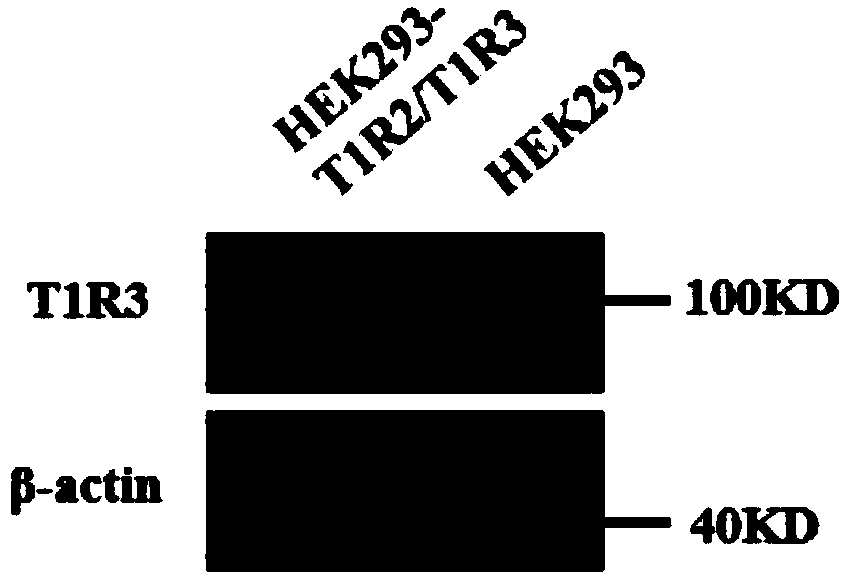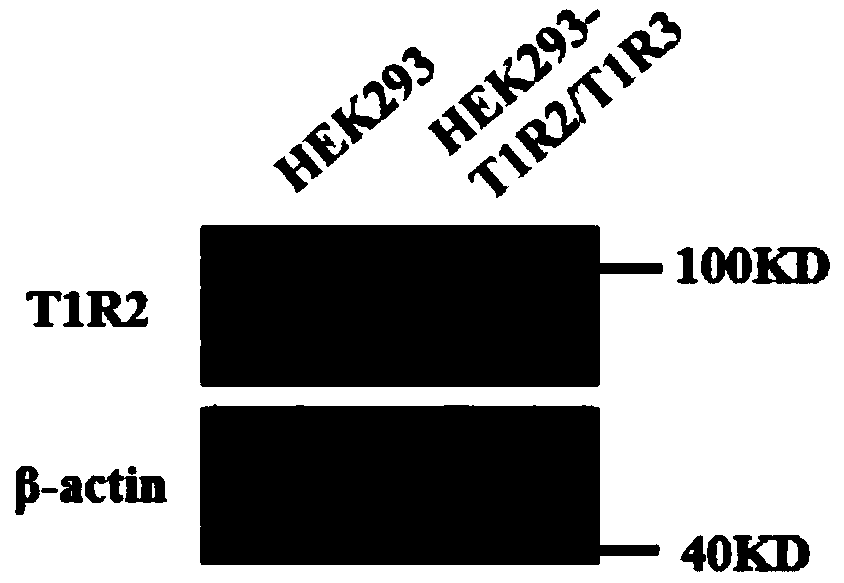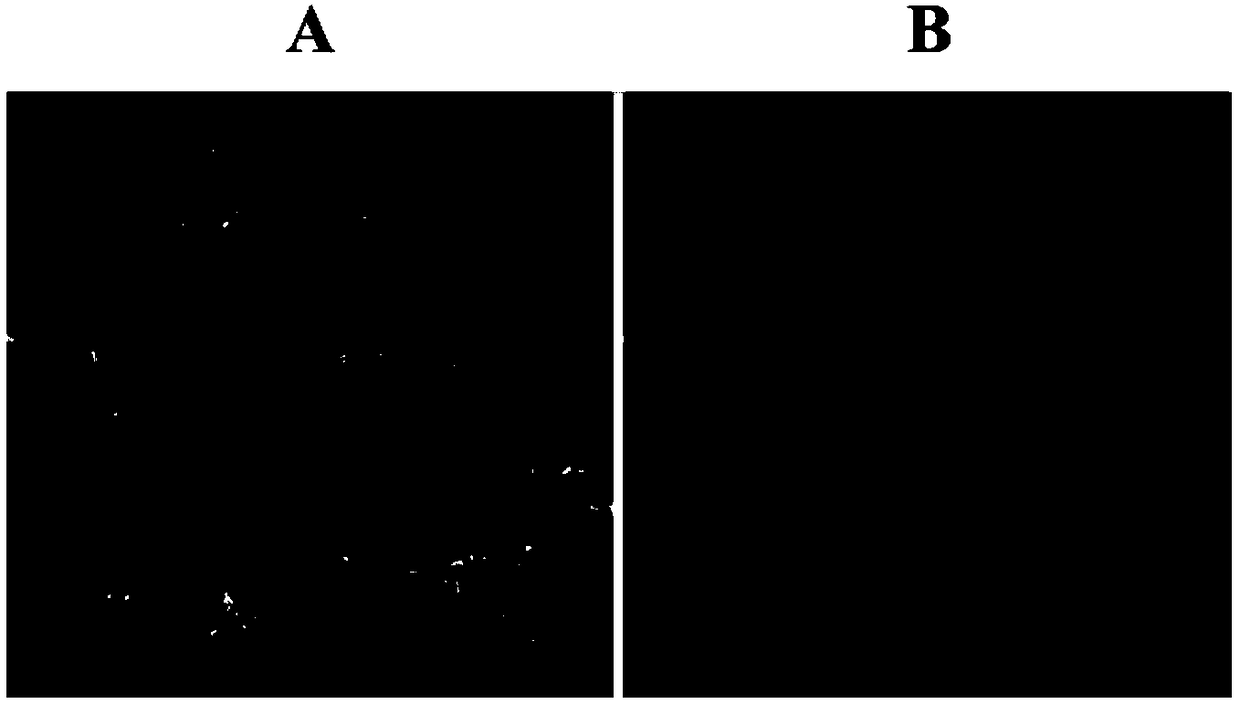Eukaryotic cell line capable of stably co-expressing recombinant human sweet taste receptor proteins and preparation method of eukaryotic cell line
A eukaryotic cell, receptor protein technology, applied in receptors/cell surface antigens/cell surface determinants, genetically modified cells, animal/human proteins, etc., can solve obesity and its associated related diseases, etc.
- Summary
- Abstract
- Description
- Claims
- Application Information
AI Technical Summary
Problems solved by technology
Method used
Image
Examples
Embodiment 1
[0055] Construction and detection of eukaryotic cell lines that stably co-express His-T1R2 and FLAG-T1R3.
[0056] 1. Construction and detection of His-T1R2 recombinant plasmid
[0057] 1.1. Design and preparation of nucleic acid sequence encoding His-T1R2
[0058] Using the nucleic acid sequence of the coding region of the human T1R2 gene as a template, a specific forward primer T1R2-F (SEQ ID No. 3) and a specific reverse primer T1R2- for encoding His-T1R2 (SEQ ID No. 2) were designed. R (SEQ ID No. 4). In the nucleic acid sequence of T1R2-F, a Hind III restriction site and a protective base are added before the start codon, and the nucleic acid sequence encoding the His tag is connected after the start codon, and then the nucleic acid sequence of the coding region of the T1R2 gene is connected. The T1R2-R nucleic acid sequence has a terminator, Xho I restriction site and protective base at the end of the T1R2 coding sequence.
[0059] Using the nucleic acid sequence of the coding...
Embodiment 2
[0090] Immunofluorescence was used to detect the expression and localization of His-T1R2 and FLAG-T1R3 sweet taste receptor proteins in eukaryotic cells.
[0091] 1. Sample preparation
[0092] By using immunofluorescence technology, we detected the expression and localization of His-T1R2 and FLAG-T1R3 in the aforementioned eukaryotic cell lines. Use fresh cell culture medium to mix 5-10x10 5 Two HEK293 cells stably co-expressing His-T1R2 and FLAG-T1R3 were planted in a 3.5cm petri dish, and a 13mm round cover glass was placed in the petri dish. When the cell coverage density reaches 50%-80%, the cover glass is taken out, fixed in phosphate buffer containing 4% paraformaldehyde, blocked by phosphate buffer containing 3% bovine serum albumin, and then used with T1R2 specific antibody (Rabbit origin) and T1R3 specific antibody (goat origin) are incubated together to remove unbound antibody, and finally incubated with anti-rabbit secondary antibody FITC antibody and anti-mouse second...
Embodiment 3
[0100] 1. Construction and detection of pLVX-Puro-HA-G15-gustducin44 recombinant plasmid
[0101] 1.1. Design and preparation of nucleic acid sequence encoding human HA-G15-gustducin44
[0102] Using the nucleic acid sequence of the coding region for expressing human Gα15 protein (SEQ ID No. 9) and the nucleic acid sequence of the coding region for expressing human Gustducin protein (SEQ ID No. 10) as templates, the chimeric protein G15 with HA tag was synthesized and encoded -The nucleic acid sequence of gustducin44 (SEQ ID No.11), which expresses a chimeric protein consisting of amino acids 1 to 340 of human Gα15 protein and amino acids 331 to 374 of human Gustducin protein with HA tag (Referred to as HA-G15-gustducin44, the sequence is shown in SEQ ID No. 12). Designed to amplify the specific forward primer G15-gustducin44-F (SEQ ID No.13) and specific reverse primer G15-gustducin44-R (SEQ ID No.11) encoding the nucleic acid sequence of HA-G15-gustducin44 (SEQ ID No.11) SEQ ID...
PUM
 Login to View More
Login to View More Abstract
Description
Claims
Application Information
 Login to View More
Login to View More - R&D
- Intellectual Property
- Life Sciences
- Materials
- Tech Scout
- Unparalleled Data Quality
- Higher Quality Content
- 60% Fewer Hallucinations
Browse by: Latest US Patents, China's latest patents, Technical Efficacy Thesaurus, Application Domain, Technology Topic, Popular Technical Reports.
© 2025 PatSnap. All rights reserved.Legal|Privacy policy|Modern Slavery Act Transparency Statement|Sitemap|About US| Contact US: help@patsnap.com



